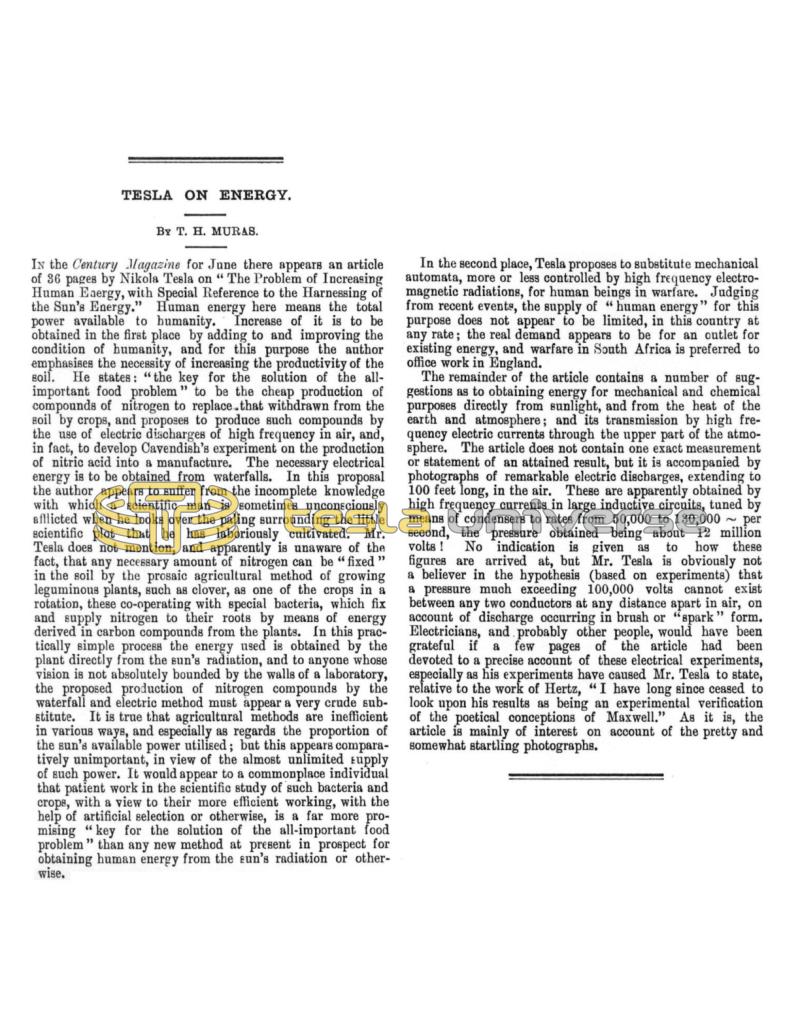
Nikola Tesla Articles
Tesla on Energy
In the Century Magazine for June there appears an article of 36 pages by Nikola Tesla on “The Problem of Increasing Human Energy, with Special Reference to the Harnessing of the Sun’s Energy.” Human energy here means the total power available to humanity. Increase of it is to be obtained in the first place by adding to and improving the condition of humanity, and for this purpose the author emphasises the necessity of increasing the productivity of the soil. He states: “the key for the solution of the all-important food problem” to be the cheap production of compounds of nitrogen to replace that withdrawn from the soil by crops, and proposes to produce such compounds by the use of electric discharges of high frequency in air, and, in fact, to develop Cavendish’s experiment on the production of nitric acid into a manufacture. The necessary electrical energy is to be obtained from waterfalls. In this proposal the author appears to suffer from the incomplete knowledge with which a scientific man is sometimes unconsciously afflicted when he looks over the paling surrounding the little scientific plot that he has laboriously cultivated. Mr. Tesla does not mention, and apparently is unaware of the fact, that any necessary amount of nitrogen can be “fixed” in the soil by the prosaic agricultural method of growing leguminous plants, such as clover, as one of the crops in a rotation, these co-operating with special bacteria, which fix and supply nitrogen to their roots by means of energy derived in carbon compounds from the plants. In this practically simple process the energy used is obtained by the plant directly from the sun’s radiation, and to anyone whose vision is not absolutely bounded by the walls of a laboratory, the proposed production of nitrogen compounds by the waterfall and electric method must appear a very crude substitute. It is true that agricultural methods are inefficient in various ways, and especially as regards the proportion of the sun’s available power utilised; but this appears comparatively unimportant, in view of the almost unlimited supply of such power. It would appear to a commonplace individual that patient work in the scientific study of such bacteria and crops, with a view to their more efficient working, with the help of artificial selection or otherwise, is a far more promising “key for the solution of the all-important food problem” than any new method at present in prospect for obtaining human energy from the sun’s radiation or otherwise.
In the second place, Tesla proposes to substitute mechanical automata, more or less controlled by high frequency electromagnetic radiations, for human beings in warfare. Judging from recent events, the supply of “human energy” for this purpose does not appear to be limited, in this country at any rate; the real demand appears to be for an outlet for existing energy, and warfare in South Africa is preferred to office work in England.
The remainder of the article contains a number of suggestions as to obtaining energy for mechanical and chemical purposes directly from sunlight, and from the heat of the earth and atmosphere; and its transmission by high frequency electric currents through the upper part of the atmosphere. The article does not contain one exact measurement or statement of an attained result, but it is accompanied by photographs of remarkable electric discharges, extending to 100 feet long, in the air. These are apparently obtained by high frequency currents in large inductive circuits, tuned by means of condensers to rates from 50,000 to 130,000 ~ per second, the pressure obtained being about 12 million volts! No indication is given as to how these figures are arrived at, but Mr. Tesla is obviously not a believer in the hypothesis (based on experiments) that a pressure much exceeding 100,000 volts cannot exist between any two conductors at any distance apart in air, on account of discharge occurring in brush or “spark” form. Electricians, and probably other people, would have been grateful if a few pages of the article had been devoted to a precise account of these electrical experiments, especially as his experiments have caused Mr. Tesla to state, relative to the work of Hertz, “I have long since ceased to look upon his results as being an experimental verification of the poetical conceptions of Maxwell.” As it is, the article is mainly of interest on account of the pretty and somewhat startling photographs.
